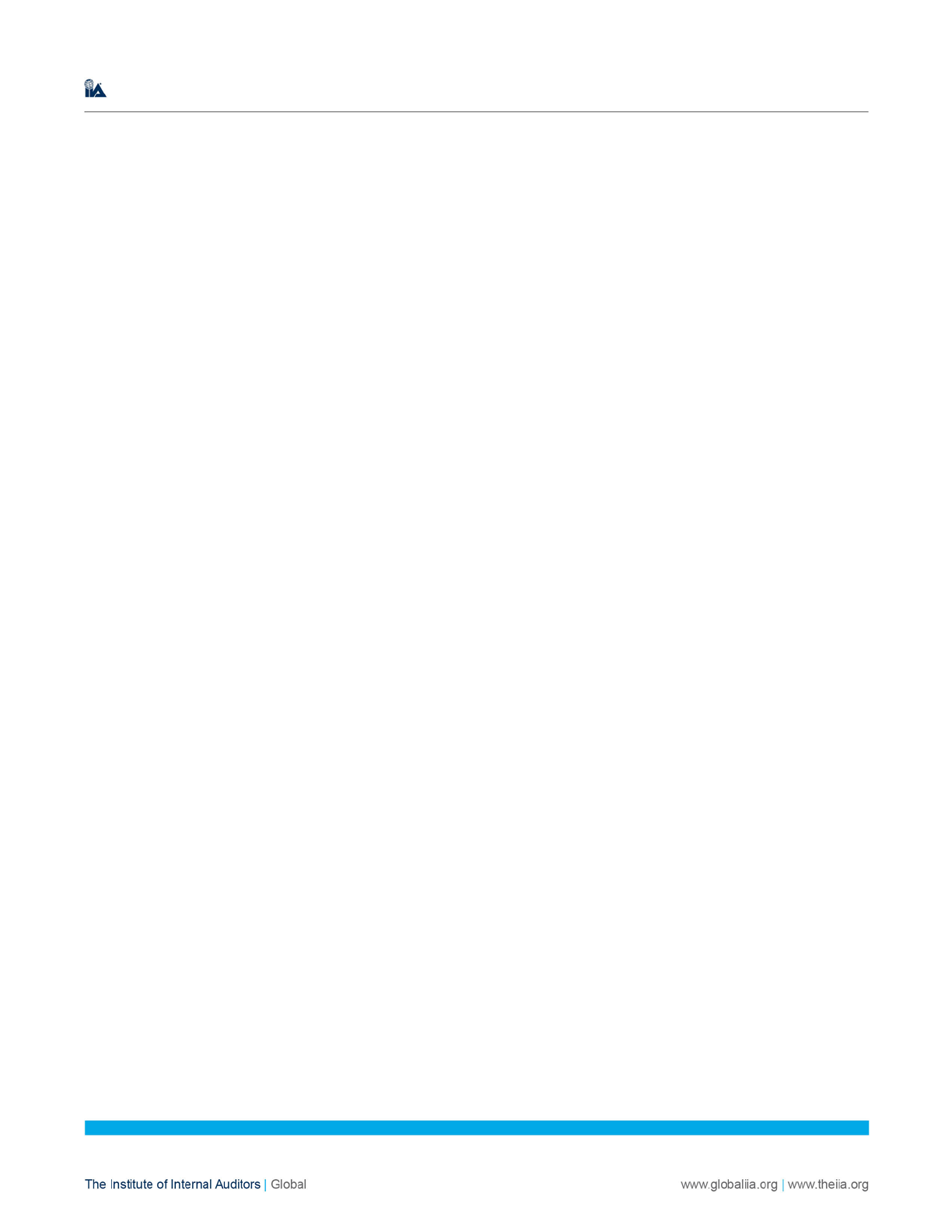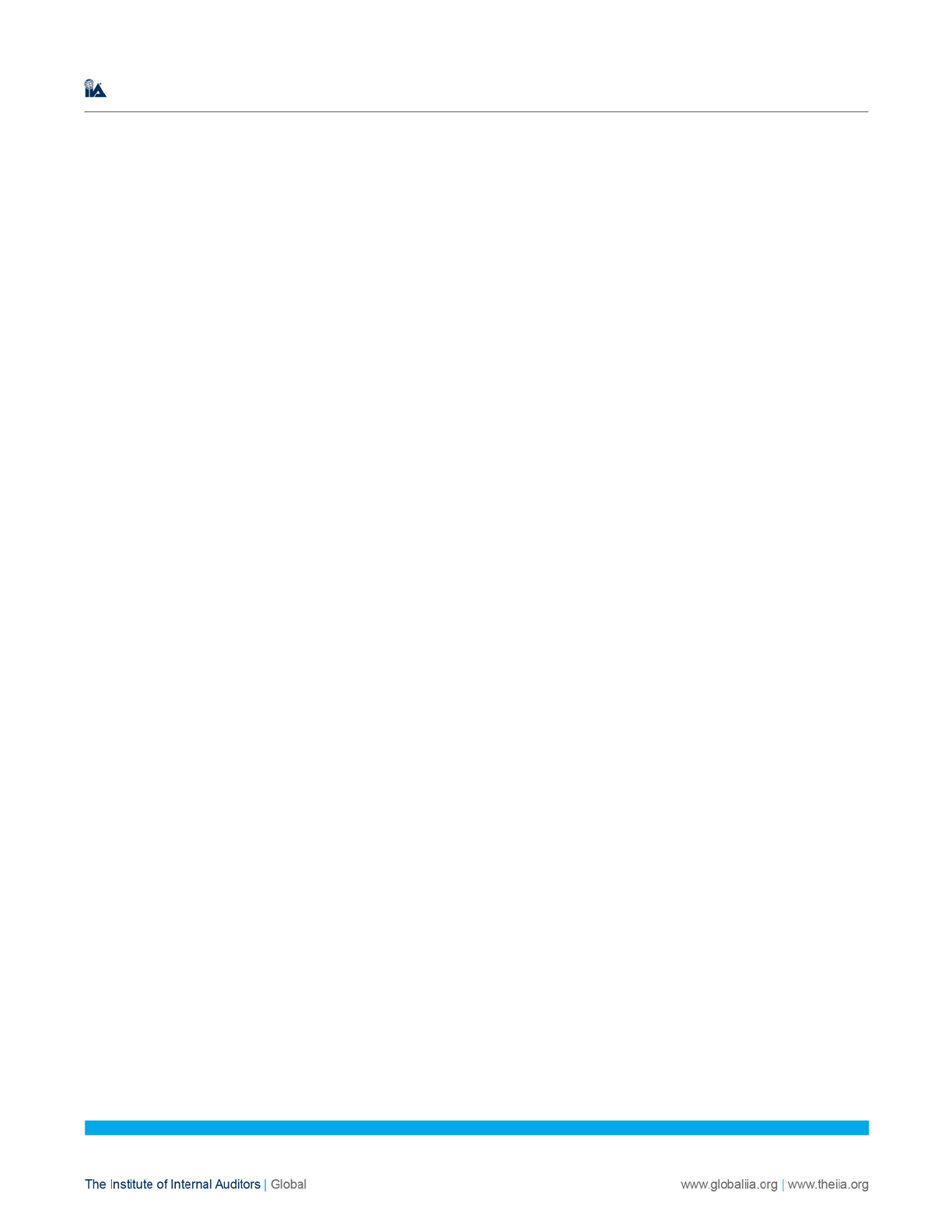
1
Standard 1311 – Internal Assessments
Internal assessments must include:
•
Ongoing monitoring of the performance of the internal audit activity.
•
Periodic self-assessments or assessments by other persons within the
organization with sufficient knowledge of internal audit practices.
Interpretation:
Ongoing monitoring is an integral part of the day-to-day supervision, review, and
measurement of the internal audit activity. Ongoing monitoring is incorporated into the
routine policies and practices used to manage the internal audit activity and uses
processes, tools, and information considered necessary to evaluate conformance with
the Code of Ethics and the
Standards.
Periodic assessments are conducted to evaluate conformance with the Code of Ethics
and the
Standards.
Sufficient knowledge of internal audit practices requires at least an understanding of all
elements of the International Professional Practices Framework.
Revised
Standards
, Effective 1 January 2017
Implementation Guide 1311

2
Implementation Guide 1311 / Internal Assessments
Getting Started
As Standard 1311 indicates, the chief audit executive (CAE) is responsible for ensuring that
the internal audit activity conducts an internal assessment that includes both ongoing
monitoring and periodic self-assessments. Internal assessments validate that the internal audit
activity continues to conform with the
International Standards for the Professional Practice of
Internal Auditing
(
Standards
) and The IIA’s Code of Ethics. The CAE understands that the
internal assessments focus on continuous improvement of the internal audit activity and
involve monitoring its efficiency and effectiveness.
The IIA’s
Quality Assessment Manual for the Internal Audit Activity
or comparable guidance
and tools may serve as a guide to conducting an internal assessment.
Considerations for Implementation
The two interrelated parts of internal assessments — ongoing monitoring and periodic self-
assessments — provide an effective structure for the internal audit activity to continuously
assess its conformance with the
Standards
and whether internal auditors apply the Code of
Ethics. Additionally, they may allow for identification of improvement opportunities.
Ongoing Monitoring
Ongoing monitoring is achieved primarily through continuous activities such as engagement
planning and supervision, standardized work practices, workpaper procedures and signoffs,
report reviews, as well as identification of any weaknesses or areas in need of improvement
and action plans to address them. Ongoing monitoring helps the CAE determine whether
internal audit processes are delivering quality on an engagement-by-engagement basis.
Generally, ongoing monitoring occurs routinely throughout the year via the implementation of
standard work practices. To facilitate this, the CAE may develop templates for internal auditors
to use throughout engagements, ensuring consistency in the application of the
Standards.
Adequate supervision is a fundamental element of any quality assurance and improvement
program (QAIP). Supervision begins with planning and continues throughout the performance
and communication phases of the engagement. Adequate supervision is ensured through
expectation-setting, ongoing communications among internal auditors throughout the
engagement, and workpaper review procedures, including timely sign-off by the individual

3
Implementation Guide 1311 / Internal Assessments
responsible for supervising engagements. Implementation Guide 2340 – Engagement
Supervision provides further guidance on internal audit supervision.
The implementation guides for the following series of standards provide further guidance on
appropriate performance of an engagement, from engagement planning through the
dissemination of results: 2200, 2300, and 2400.
Additional mechanisms commonly used for ongoing monitoring include:
•
Checklists or automation tools to provide assurance on internal auditors’ compliance
with established practices and procedures and to ensure consistency in the
application of performance standards.
•
Feedback from internal audit clients and other stakeholders regarding the efficiency
and effectiveness of the internal audit team. Feedback may be solicited immediately
following the engagement or on a periodic basis (e.g., semi-annually or annually) via
survey tools or conversations between the CAE and management.
•
Staff and engagement key performance indicators (KPIs), such as the number of
certified internal auditors on staff, their years of experience in internal auditing, the
number of continuing professional development hours they earned during the year,
timeliness of engagements, and stakeholder satisfaction.
•
Other measurements that may be valuable in determining the efficiency and
effectiveness of the internal audit activity. Measures of project budgets, timekeeping
systems, and audit plan completion may help to determine whether the appropriate
amount of time is spent on all aspects of the audit engagement. Budget-to-actual
variance can also be valuable measurement to determine the efficiency and
effectiveness of the internal audit activity.
In addition to validating conformance with the
Standards
and Code of Ethics, ongoing
monitoring may identify opportunities to improve the internal audit activity. In such cases, the
CAE typically addresses these opportunities and may develop an action plan. Once changes
are implemented, key performance indicators can be used to monitor success. Results of
ongoing monitoring should be reported to the board at least annually, as required by Standard
1320 – Reporting on the Quality Assurance and Improvement Program.

4
Implementation Guide 1311 / Internal Assessments
Periodic Self-assessments
Periodic self-assessments have a different focus than ongoing monitoring in that they generally
provide a more wholistic, comprehensive review of the
Standards
and the internal audit
activity. In contrast, ongoing monitoring is generally focused on reviews conducted at the
engagement level. Additionally, periodic self-assessments address conformance with every
standard, whereas ongoing monitoring frequently is more focused on the performance
standards at the engagement level.
Periodic self-assessments are generally conducted by senior members of the internal audit
activity, a dedicated quality assurance team or individual within the internal audit activity who
has extensive experience with the International Professional Practices Framework (IPPF),
Certified Internal Auditors, or other competent internal audit professionals who may be
assigned elsewhere in the organization. Whenever possible, it is advantageous to include
internal audit activity staff in the self-assessment process, as it can serve as a useful training
opportunity to improve internal auditors’ understanding of the IPPF.
The internal audit activity conducts periodic self-assessments to validate its continued
conformance with the
Standards
and Code of Ethics and to evaluate:
•
The quality and supervision of work performed.
•
The adequacy and appropriateness of internal audit policies and procedures.
•
The ways in which the internal audit activity adds value.
•
The achievement of key performance indicators.
•
The degree to which stakeholder expectations are met.
To accomplish this, the individual or team conducting the self-assessment typically assesses
each standard to determine whether the internal audit activity is operating in conformance.
This may include in-depth interviews and surveys of stakeholders. Through this process, the
CAE is typically able to assess the quality of the internal audit activity’s audit practices,
including adherence to policies and procedures for conducting engagements. Periodic self-

5
Implementation Guide 1311 / Internal Assessments
assessments may be conducted by a member of the internal audit activity or by other persons
within the organization with sufficient knowledge of internal audit practices, specifically the
Standards
and Code of Ethics.
The internal audit activity may perform additional steps to support the periodic self-
assessment, such as conducting post-engagement reviews or analyzing KPIs.
•
Post-engagement review – The internal audit activity may select a sample of
engagements from a particular timeframe and conduct a review to assess compliance
with internal audit policies (see Standard 2040 – Policies and Procedures) and
conformance with the
Standards
and Code of Ethics. These reviews are typically
conducted by internal audit staff who were not involved in the respective
engagement. In a larger or more mature organization, this process may be handled
by a quality assurance specialist or team. In smaller organizations, the CAE or the
individual responsible for reviewing workpapers may use a checklist, completed after
the final report is issued, to accomplish this review and close the file.
•
KPI analysis – The internal audit activity may also monitor and analyze KPIs related
to the efficiency of standard internal audit work practices (e.g., budget-to-actual
engagement hours, percentage of the audit plan completed, number of days between
fieldwork completion and report issuance, percentage of audit observations
implemented, and timeliness of corrections related to audit observations). Other
commonly used metrics include the number of certified internal auditors on staff, their
years of experience in internal auditing, and the number of continuing professional
development hours they earned during the year.
Following a periodic self-assessment, where appropriate, the CAE may develop an action plan
to address opportunities for improvement. This plan should include proposed timelines for
actions.
Results of periodic self-assessments, which indicate the internal audit activity’s level of
conformance with the
Standards
and Code of Ethics, must be communicated to the board
upon completion, as required by Standard 1320. A periodic self-assessment performed shortly

6
Implementation Guide 1311 / Internal Assessments
before an external assessment may help reduce the time and effort required to complete the
external assessment (see Standard 1312 – External Assessments).
Considerations for Demonstrating Conformance
Multiple items may indicate conformance with Standard 1311, including any evidence that
ongoing monitoring activities were completed according to the internal audit activity’s QAIP.
Examples may include completed checklists that support workpaper reviews, survey results,
and KPIs related to the efficiency and effectiveness of the internal audit activity, such as an
analysis of budget-to-actual engagement hours. In addition, conformance may be
demonstrated by documentation of completed periodic assessments, which include the scope
of the review and approach plan, workpapers, and communication reports. Finally,
presentations to the board and management, meeting minutes, and the results of both ongoing
monitoring and periodic self-assessment
—
including corrective action plans and corrective
actions taken to improve conformance, efficiency, and effectiveness
—
may indicate
conformance.

7
Implementation Guide 1311 / Internal Assessments
About The IIA
The Institute of Internal Auditors (The IIA) is the internal audit profession’s most widely recognized advocate, educator,
and provider of standards, guidance, and certifications. Established in 1941, The IIA today serves more than 180,000
members from more than 170 countries and territories. The association’s global headquarters are in Lake Mary, Fla.
For more information, visit www.globaliia.org or www.theiia.org.
About Implementation Guidance
Implementation Guidance, as part of The IIA’s International Professional Practices Framework® (IPPF®), provides
recommended (nonmandatory) guidance for the internal audit profession. It is designed to assist both internal auditors
and internal audit activities to enhance their ability to achieve conformance with the
International Standards for the
Professional Practice of Internal Auditing
(
Standards
).
Implementation Guides assist internal auditors in applying the
Standards
. They collectively address internal audit's
approach, methodologies, and consideration, but do not detail processes or procedures.
For other authoritative guidance materials provided by The IIA, please visit our website at
www.globaliia.org/standards-guidance or www.theiia.org/guidance.
Disclaimer
The IIA publishes this document for informational and educational purposes. This guidance material is not intended to
provide definitive answers to specific individual circumstances and, as such, is only intended to be used as a guide.
The IIA recommends that you always seek independent expert advice relating directly to any specific situation. The IIA
accepts no responsibility for anyone placing sole reliance on this guidance.
Copyright
Copyright
®
2016 The Institute of Internal Auditors. For permission to reproduce, please contact guidance@theiia.org.
